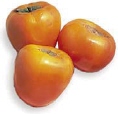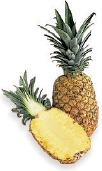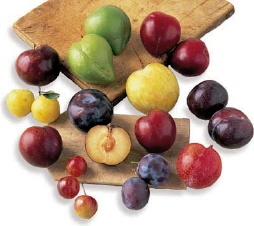
PERSIMMONS

Availability
October through February
Buying Tips
The most common persimmon is the Hachiya. It is deep orange, heart-shaped, and eaten raw or cooked.
This persimmon must be ripened until very soft and almost translucent before using, or it will be inedibly tannic. Fuyu persimmons are pale orange and squat with a light bloom covering the skin. They are preferred for salads and are firm even when ripe.
Buy slightly firm, plump fruit with smooth, unbroken skin and the stem cap still attached; ripen at home. If you buy soft-ripe fruit, transport it very carefully and use the same day. Avoid purchasing bruised or cracked fruit.
To Store
Ripen Hachiya persimmons at room temperature in a closed brown paper bag until very soft. Refrigerate and use within one or two days. Hachiya pulp freezes very well in an airtight container for up to two months.
To Prepare
Remove the stem cap. To use Hachiya pulp, cut persimmon in half and, with a spoon, scoop out the soft flesh; discard the seeds. Puree in a blender or food processor, or press through a fine sieve. To enjoy Fuyu persimmons, simply peel and slice.
PINEAPPLES

Availability
Year round
Buying Tips
A pineapple’s color depends on the variety: It can range from deep yellow to reddish brown to green. Pineapple is always picked ripe: It does not get sweeter with time, it only softens. Pick a pineapple that is slightly soft with a deep sweet fragrance. The leaves should be firm and green. Avoid fruit with soft spots or dark areas.
To Store
If you like, chill pineapples before serving.
To Prepare
For rings or chunks, cut off the crown and stem end. Stand the pineapple upright and slice off the rind and eyes. Place the fruit on its side and cut crosswise into ¼- to 1-inch-thick slices. Core the pineapple with a pineapple corer or knife and cut into chunks, if desired. For wedges, with a long serrated knife, cut fruit lengthwise in half, then into quarters, cutting from the crown to the stem. Slice off the core by cutting along the top of the wedges, then slide a knife between the rind and flesh, keeping the knife close to the rind. Leave the flesh in the shell and cut each wedge into ¼- to ½-inch-thick slices.
PLUMS

Availability
June through September
Buying Tips
A plum’s sweetness does not increase after it is picked, so purchase ripe fruit. Color is determined by the variety. Ripe plums should be plump and evenly colored and yield to gentle pressure. If the powdery bloom is still on the skin, it’s a sign they haven’t been overhandled. Avoid hard, shriveled, or cracked plums.
Greengage A round, very sweet, perfumed fruit with greenish yellow skin. Damson and Mirabelle plums are members of the same family.
Italian prune plums These are purplish black, oval, freestone plums. Because the flesh is somewhat dry, this plum is best cooked or dried. Look for them from late summer through early autumn.
Santa Rosa One of the most popular plum varieties. Grown primarily in California, this excellent all-purpose plum has juicy, sweet-tart flesh. Friar and Queen Anne plums are related to the Santa Rosa and have similar qualities.
Wild plums Although the name varies depending on the locale (from the Sierra plum in the West to the beach plum along the Atlantic Coast), these small plums grow in bunches and are used to make jams and jellies.
To Store
Refrigerate ripe plums and use within five days.
To Prepare
Wash plums, then cut into each center to remove the pit, if desired. For serving, slice or cut up the fruit, with or without the skin. When cooked, the amount of sugar needed will depend on the variety.